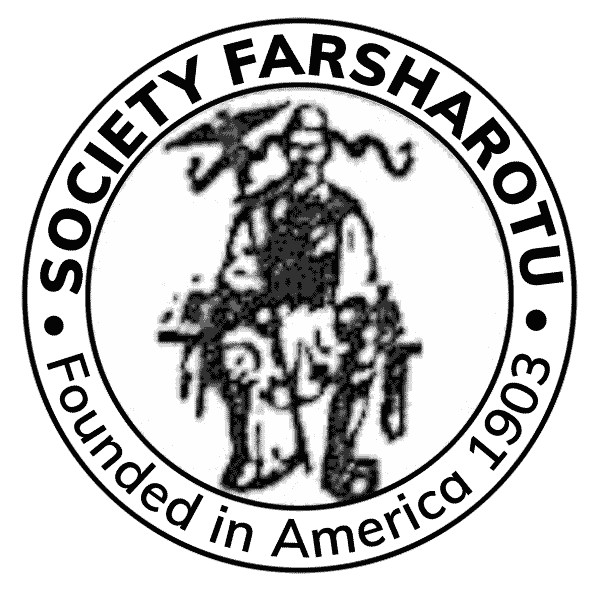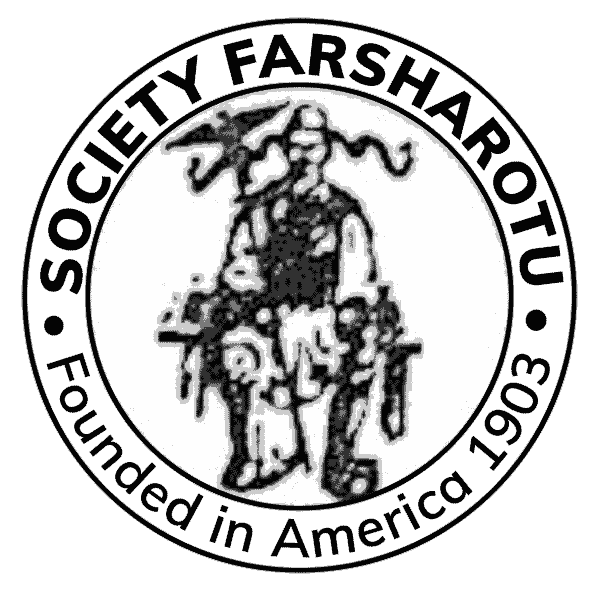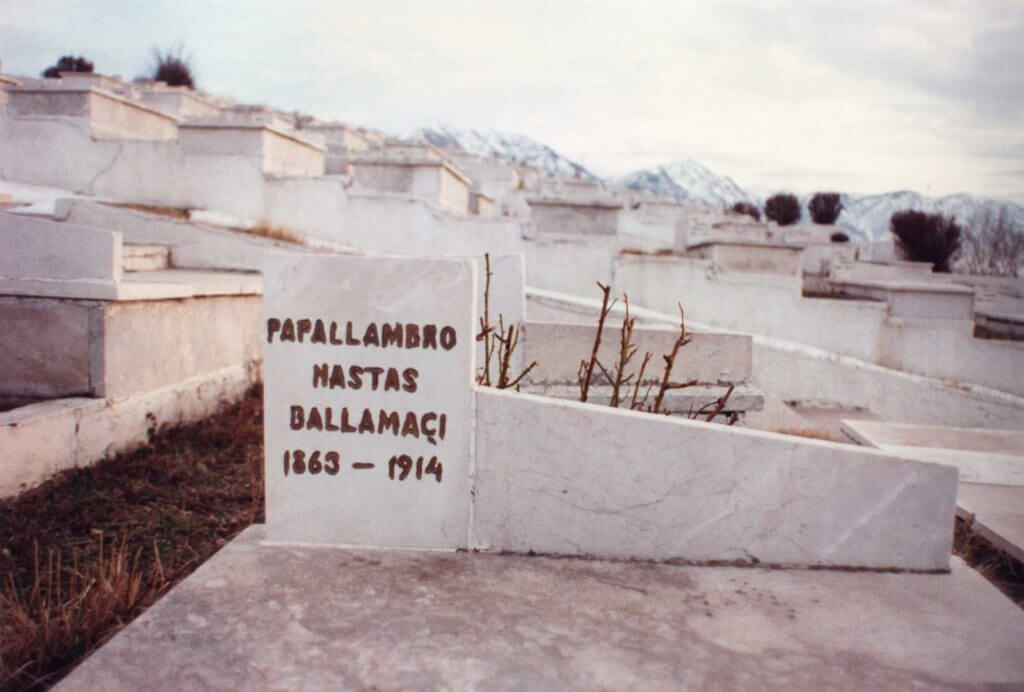Community News
We welcome with great pleasure new member Terry A. Terezi of Florida, whose parents hailed from the once famous town of Voskopolje.
As announced by President Robert Nicola at the 90th Anniversary Dinner Dance, the Society wishes to express its deepest appreciation to Ms. Margaret Caciavely for her generous donation in memory of her late brother, Tom.
Society member, respected teacher and potter Victor Babu, son of Athanas and Norma Babu of New York City, held a “New Works” exhibit at the Morgan Gallery in Kansas City, Mo. from January 7 through February 28 of this year. Victor says, “As a visual artist, I must trust my eye. I can only hope that my personal understanding of material, craft, form, and decoration, combine to reveal what that eye remembers of beauty.” We hear the show was a huge success and wish Vic many more with continued inspiration to explore his craft.
Another artist is sculptor Peter Demetrius Tegu, son of our own versatile correspondent Professor T. Steven Tegu. A working artist for the past ten years, Peter expressed his approach to sculpting in an article in The Providence Journal-Bulletin: “I take forms and inject new energy to create a fusion of 20th century culture with the look of Medieval Futurism…The pendulum…swings from the classical to the future. All artists are struggling to create new forms, and the honesty of form reflects how I perceive myself.” Several of his works went on display in early February at the Custom House Tavern in Providence.
We were saddened to learn from the September 1, 1993 front page of the Greek-language daily Proini of the furious forest fires that raged near Metsovo, Pades, Valea Kalda and several other Aromanian villages in Epiros and Macedonia, as well as in villages in other parts of the mainland and Greek isles. These tragic fires happen every year because of drought, carelessness and even arson.
The Society announces that its second financial grant was awarded to Stephen A. Stertz, Adjunct Assistant Professor of History at Kean College, Union, New Jersey. Prof. Stertz will research the lower Danube region in late antiquity and early Byzantine times, focusing on the extent of the Roman withdrawl from that region — an unexplained void in history, which is of key importance in reconstructing the much disputed genesis of the Romanian and Vlach peoples. As Patrick Leigh Fermor keenly observed, this in an area of history where “Obscurity reigns …a dim region where suggestio falsi and suppresio veri, those twin villains of historical conflict, stalk about the shadows with dark-lantern and bow-string.”
After two years the United States Government has finally recognized the Former Yugoslavian Republic of Macedonia (FYROM). Because of objections by the Greek Government, a strong Greek-American lobby and the ongoing war in Bosnia, Washington has delayed its planned recognition of this small, ethnically diverse Balkan republic. However, last December six European nations recognized Macedonia, encouraging further international support. President Clinton sent 300 American troops to Macedonia last summer to discourage expansion of war in the region and more are on their way to replace Scandanavian soldiers who will strenghten the peace-keeping force in Bosnia. Greek Prime Minister Papandreou responsed by suspending movement of goods from the port of Salonika to FYROM, allowing only food and medicine to cross that border. These actions infuriated members of the European Community, over which Greece presides this year. Large rallies protesting U.S. recognition took place in Salonika and in the Greek diaspora communities around the world.
Most recently Australia, which has the second largest Greek diaspora after America, has granted diplomatic recognition to FYROM. The GreekAmerican recently reported an arson attempt at the Pan Macedonian Union of Melbourne and Victoria, a building belonging to the Greek diaspora, on Monday morning, February 21st. The attack came less than 24 hours after a fire gutted the Macedonian Orthodox Church of St. Nicholas in Preston. Australian government officials are concerned that the animosity between Greeks and Slavs may explode into serious violence.
From the Albanian-American newspaper Illyria, we learn that FYROM will undertake a new costly census of citizens, households, apartments and agricultural estates in April 1994 (at press time, this census had been postponed indefinitely). The 1991 census recorded 2 million people, including other ethnic groups. Albanians and Serbs dispute the official figures. This may be the last chance for the Aromani there to stand up and be counted. The ’91 census found only 8,000 Vlachs in the country.
We all know that what goes up must come down, but Aromanian population statistics seem to continually defy gravity. The March 12 GreekAmerican reported that “Greek teachers are urging a new census be taken in Skopje, saying there were strong indications of a sizeable Greek minority in the neighboring state. Academics attending a one-day conference in Thessaloniki, northern Greece, said the Greek minority in the neighboring state included native Greeks, political refugees from Greece and Vlachs. They said the minority was dominated by about 150,000 Vlachs who live in the area of Manastir, Krousovo, Doirani and Skopje, the capital of the neighboring Balkan republic.”
Helsinki Watch, the Human Rights organization, has just published its report (Vol. 6, Issue I) on “Human Rights in the Former Yugoslav Republic of Macedonia.” The following passage refers to the Vlach presence there:
“In July, Nikola, a fifty-year-old Vlach, told Helsinki Watch in Bitola, in southern FYROM, that `Vlachs don’t have any problem now. In Tito’s time, we were afraid to say we were Vlachs, and we were afraid to talk in the Vlach language. But since Yugoslavia fell apart, we are proud to be Vlachs and proud of our culture. Our sons and nephews don’t speak Vlach, but that’s all right. Our children don’t learn Vlach in school. Until 1918 there were Vlach schools in Bitola, but they were burned down after World War I and many people left. In the cities, Vlachs were too scattered to have their own schools.
`There aren’t many Vlachs now, and the written language has been lost — some people are trying to recreate it. I can read a little Vlach, not much. Every village had its own dialect in the old days; it’s related to Romanian. There’s no job discrimination against Vlachs by the state, at least not at present.’
Norman Anderson, the head of the CSCE Spillover Monitor Mission in Skopje, told Helsinki Watch that Vlachs are well-integrated into Macedonian society, and do not claim to have problems of discrimination.”
We’ve often said that Albania is a study in contrasts. Compare these two reports on its economy:
From Illyria, we learn that the International Monetary Fund (IMF) forecasts GDP growth of 8% this year and 5% in both 1995 and 1996. Construction has shown the most dramatic recovery and the IMF forecasts further growth of 14% in building this year. Performance was also up in agriculture (14.4%), transport (13%) and services (11.5%). Farm output is expected to grow 8.2% this year, transport by 14.4% and services by 9.5%. However, industry fell by 10%, following a massive fall of 60% in 1992. The IMF said industrial output should stabilize this year.
In The Economist, we read that “Albania’s economy is in grisly shape. Unemployment in the towns is probably about 60%. The country cannot pay its foreign commercial debts. Parliament has just passed a budget which proposes the spending of $741 million in the coming year, even though tax income and foreign assistance together is expected to be no more than $461 million. . .Unsurprisingly, foreign investment hardly exists.”
From the New York Times we learn Europe’s eight million plus Romanies (Gypsies) are organizing Human Rights meetings and congresses across the continent after recent physical attacks on Gypsies, including village burnings, in several of the former communist nations. They hope to protect, promote and develop their unique (and often stereotyped) culture. A four- day conference was organized last spring in a former royal villa near Lake Snagov, Romania. Because the Romanies’ Sanskrit-based language has produced many varying dialects, French and English interpreters had to be utilized. The resulting “Snagov Declaration” urged European governments and international organizations to pay more attention to Gypsy issues.
There are 30 million indigenous Indians in Latin America, and their languages and traditions are constantly receding in the face of Western civilization and languages. The Inter-American Fund and the United Nations are discussing the creation of a $40 million fund to help these indigenous groups.
Cincinnati’s city council passed a human rights ordinance one year ago to protect the 250,000 mountain people known as Appalachians, who have recently migrated to the area, making them the only group there singled out for protection against discrimination. Although the chief council felt one group should not be identified alone as experiencing discrimination, and even the Director of the city’s Urban Appalachian Council knows of not even one documented case of discrimination, UAC studies have found an 80% school dropout rate stemming from teachers’ expectations about “hillbillies.” Individual mountain people testified about discrimination resulting from stereotypes associated with Appalachian poverty. One result: the Los Angeles Times has decided to avoid the words “hick” and “hillbilly” on its pages.
For decades, Chinese communist authorities have been trying to promote the use of Mandarin, the dialect of Beijing, among all Chinese, though not always with success. Especially resistant to assimilation is Cantonese, the language of the southern province of Guangdong. Communist officials are upset that many Cantonese speakers feel their langauge is as good as, if not better than Mandarin.
The Economist reported on the publication of Routledge’s Atlas of the World’s Languages, which attempts to map the location of all the world’s tongues, major and minor, those with literature and those unwritten:
“The book is divided into eight sections: the Americas, Australasia and the Pacific, East and South-East Asia, South Asia, Northern Asia and Eastern Europe, Western Europe, the Middle East and North Africa, and the sub-Saharan Africa. Some languages have fewer than 100 speakers and so are perilously close to extinction. An extra tidbit has been added to the sections devoted to Australia and the Americas. `Time of contact’ maps try to measure what effect European settlement had upon native languages.
“This atlas’s extraordinary attention to detail is astonishing. Its prognosis that half the world’s langauges alive today may disappear within a century is the scholarly equivalent of a seismic shock. So is its price ($599.95).”
Rob Talabac went to the New York Public Library’s Map Room to examine the book’s section on Europe. The Atlas identifies “Macedo-Romanian” speakers in Greece (50,000 in 1973), and mentions “Megleno-Romanian” in a small pocket north of Salonika. The map of Albania sites “Macedo-Romanians” in the southeast around Korce, but does not indicate its speakers in southwestern Albania. None are listed for FYROM and Bulgaria, although “Romanian” speakers are shown around eastern Serbia. Surprisingly, “Aromanian” and “Vlach” are not used, although this is how we are now most often classified in the West. The book does mention the “Vlach Romany,” but this designates a particular dialect spoken by East European Gypsies.
As the Atlas itself admits:
“Finally, the maps do no more than hint at the degree to which speakers of minority languages (there are few states in western Europe that are without linguistic minorities) are currently seeking to (re)establish their identity, demanding substantial recognition in government, education, and the media. There can be no doubt, however, that the survival of many of these languages into the twenty-first century is threatened by a deadly combination of, on the one hand, official apathy (in some cases, even willful neglect) and, on the other, lack of interest among the population in preserving the endangered language, which they may see as more of a liability than an advantage.”
The meticulous, scholarly –and often dry — “Blue Guide” travel series is scheduled to publish its premiere edition on Albania this March. Hopefully, its gifted writer, British journalist and broadcaster James Pettifer, will brush aside antiquity’s cobwebs and overcome the gloom of Orwellian concrete bunkers to paint a penetrating, compassionate, and acurate portrait of this struggling, fascinating land.



Responses